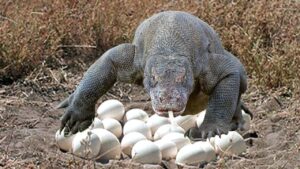The Komodo dragon, renowned as the largest lizard on Earth, has long captured the fascination of researchers, wildlife enthusiasts, and curious minds alike. Revered for its formidable size, powerful jaws, and ancient lineage, this apex predator inhabits the rugged terrain of the Indonesian archipelago.
Amidst the intrigue surrounding this iconic reptile lies a fundamental question: Does the Komodo dragon lay eggs? Delving into the realms of biology, ecology, and evolutionary history, this inquiry unveils captivating insights into the life cycle and reproductive strategies of one of nature’s most captivating creatures.
Does komodo dragon lay eggs?

Komodo dragons, like many other reptiles, reproduce through a process called oviparous reproduction, which involves laying eggs. After mating, female Komodo dragons dig a nest in the ground using their powerful claws and lay their eggs inside. The nest is typically located in a secluded spot, such as a burrow or a mound of vegetation, to provide protection for the eggs.
Once the eggs are laid, the female covers them with soil and other materials to help regulate temperature and humidity levels within the nest. The eggs then undergo a period of incubation, during which they are kept warm and moist. This incubation period typically lasts for several months, depending on factors such as temperature and environmental conditions.
When the eggs are ready to hatch, the baby Komodo dragons, known as hatchlings, use their egg tooth to break out of their shells. They then emerge from the nest and must fend for themselves from the moment they hatch. Komodo dragon hatchlings are vulnerable to predation and face many challenges as they grow and develop into adults.
Reproductive characteristics of Komodo dragons
Komodo dragons (Varanus komodoensis) possess several unique reproductive characteristics:
- Oviparity: Komodo dragons are oviparous, meaning they reproduce by laying eggs. After mating, females excavate nests in the ground where they deposit their eggs.
- Clutch size: A female Komodo dragon can lay a relatively large clutch of eggs, typically ranging from around 15 to 30 eggs per clutch, although larger clutches have been recorded.
- Nesting behavior: Females exhibit maternal care by constructing nests for their eggs. They dig burrows in the soil, often in secluded areas such as hillsides or along riverbanks, to create a suitable environment for egg incubation.
- Incubation period: The eggs are buried in the nest and left to incubate. The incubation period lasts several months, usually between 7 and 9 months, during which the eggs develop and hatch.
- Temperature-dependent sex determination (TSD): Like many reptiles, the sex of Komodo dragon hatchlings is determined by the temperature at which the eggs are incubated. Warmer temperatures during incubation tend to produce male hatchlings, while cooler temperatures result in female hatchlings. This phenomenon is known as temperature-dependent sex determination (TSD).
- Independent offspring: Once the hatchlings emerge from the eggs, they are fully independent and must fend for themselves from the outset. There is no parental care beyond the nesting period, and hatchlings face significant risks from predation and environmental factors.
- Slow growth rate and delayed sexual maturity: Komodo dragons have a slow growth rate, and it takes several years for them to reach sexual maturity. This delayed maturation contributes to their overall reproductive strategy and life history.
These reproductive characteristics reflect the evolutionary adaptations of Komodo dragons to their natural environment and life history strategies.


